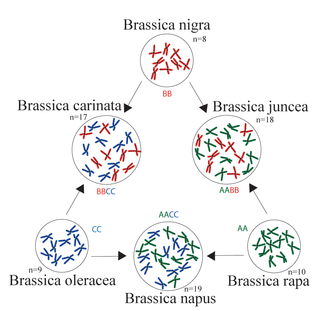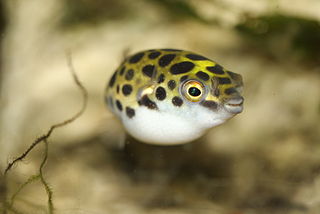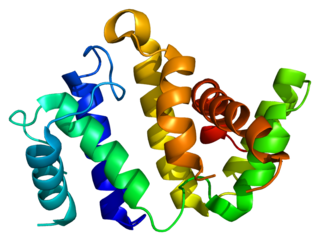
Actinopterygii, members of which are known as ray-finned fish or actinopterygians, is a class of bony fish that comprise over 50% of living vertebrate species. They are so called because of their lightly built fins made of webs of skin supported by radially extended bony spines, as opposed to the bulkier, fleshy lobed fins of the sister class Sarcopterygii. Resembling folding fans, the actinopterygian fins can change shape and wetted area easily, providing superior thrust-to-weight ratios per movement compared to sarcopterygian and chondrichthyian fins. The fin rays attach directly to the proximal or basal skeletal elements, the radials, which represent the articulation between these fins and the internal skeleton.

Salmonidae is a family of ray-finned fish that constitutes the only currently extant family in the order Salmoniformes, consisting of 11 extant genera and over 200 species collectively known as "salmonids" or "salmonoids". The family includes salmon, trout, char, graylings, freshwater whitefishes, taimens and lenoks, all coldwater mid-level predatory fish that inhabit the subarctic and cool temperate waters of the Northern Hemisphere. The Atlantic salmon, whose Latin name became that of its genus Salmo, is also the eponym of the family and order names.

Zweibrücken is a town in Rhineland-Palatinate, Germany, on the Schwarzbach river.

The doctrine of signatures, dating from the time of Dioscorides and Galen, states that herbs resembling various parts of the body can be used by herbalists to treat ailments of those body parts. A theological justification, as stated by botanists such as William Coles, was that God would have wanted to show men what plants would be useful for.

The triangle of U is a theory about the evolution and relationships among the six most commonly known members of the plant genus Brassica. The theory states that the genomes of three ancestral diploid species of Brassica combined to create three common tetraploid vegetables and oilseed crop species. It has since been confirmed by studies of DNA and proteins.
Bipont Editions, the name of a famous series of editions, in 50 volumes, of Greek and Latin classical authors, so called from Bipontium, the modern Latin name of Zweibrücken in the Rhineland-Palatinate where they were first issued by the Societas Bipontina in 1779. Their place of publication was afterwards transferred to Strasbourg.

The County Palatine of Veldenz was a principality in the contemporary Land Rhineland-Palatinate with full voting rights to the Reichstag. The county was located partially between Kaiserslautern, Sponheim and Zweibrücken, partially on the Mosel in the Archbishopric of Trier. A municipality of the same name, Veldenz, and a castle, Schloss Veldenz, are located in the district of Bernkastel-Wittlich.

Dichotomyctere nigroviridis is one of the pufferfish known as the green spotted puffer. It is found across South and Southeast Asia in coastal freshwater, but survives the longest in brackish to saltwater, and brackish water habitats. D. nigroviridis reaches a typical maximum length of about 15 cm (6 in) (5.9 in), with reports of up to 17 cm (6.7 in). In February 2009, it was successfully bred in captivity at University of Florida using a new variation of the ovarian lavage technique.

The type-I interferons (IFN) are cytokines which play essential roles in inflammation, immunoregulation, tumor cells recognition, and T-cell responses. In the human genome, a cluster of thirteen functional IFN genes is located at the 9p21.3 cytoband over approximately 400 kb including coding genes for IFNα, IFNω (IFNW1), IFNɛ (IFNE), IFNк (IFNK) and IFNβ (IFNB1), plus 11 IFN pseudogenes.

Rho GTPase activating protein 26 (ARHGAP26) also known as GTPase Regulator Associated with Focal Adhesion Kinase (GRAF) is a protein that in humans is encoded by the ARHGAP26 gene.

Oswald Croll or Crollius was an alchemist, and professor of medicine at the University of Marburg in Hesse, Germany. A strong proponent of alchemy and using chemistry in medicine, he was heavily involved in writing books and influencing thinkers of his day towards viewing chemistry and alchemy as two separate fields.

Christian II was the Duke of Birkenfeld-Bischweiler from 1654, the Duke of Zweibrücken-Birkenfeld from 1671, and the Count of Rappoltstein from 1673 until 1699.
The Emichones were an early medieval family in the southwestern German region. Its members were counts (Gaugrafen) in the Nahegau, perhaps as undercounts of the Salian dynasty. The conventional name Emichones is due to the prevailing first name "Emich". Several later families may trace their origins to the Emichones.
Georg Christian Crollius was a German historian and librarian.
Stanislas Lyonnet is a French geneticist. As of 2012 he was Professor of genetics at Paris Descartes University, and a clinical geneticist in the Department of Medical Genetics at the Hôpital Necker - Enfants Malades. His research is aimed at isolating the genes that cause congenital malformation and birth defects.
Akshara is a term used in the traditional grammar of the Sanskrit language and in the Vedanta school of Indian philosophy.
Erluin was a ninth-century Carolingian nobleman who became prefect of the palace at Ingelheim.

Podopinae, known as turtle bugs, are a subfamily of the insect family Pentatomidae. The type genus is Podops.












